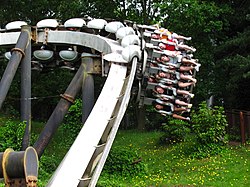
Back Inverted Coaster German Montaña rusa invertida Spanish Montagnes russes inversées French Inverted coaster Italian Omgekeerde achtbaan Dutch Inverted roller coaster SIMPLE Inverterad berg- och dalbana Swedish
This article needs additional citations for verification. (December 2018) |
| Inverted roller coaster | |
|---|---|
 Nemesis at Alton Towers in 2010 | |
| Status | In Production |
| First manufactured | 1992 |
| No. of installations | 189 |
| Manufacturers | Bolliger & Mabillard, Vekoma, Intamin, Gerstlauer, and Mack Rides |
| Vehicles | Suspended trains |
| Restraint Style | Over-the-shoulder (most common style) |
An inverted roller coaster is a type of steel roller coaster in which the train runs under the track with the seats directly attached to the wheel carriage. Riders are seated in open cars, letting their feet swing freely. The inverted coaster was pioneered by Swiss roller coaster manufacturer Bolliger & Mabillard in the early 1990s with the development of Batman: The Ride, which opened at Six Flags Great America on May 9, 1992.

Versions of inverted coasters have since been produced by other major coaster manufacturers such as Vekoma and Intamin. Intamin has few designs classified as inverted coasters, although they do install inverted coaster trains on some of their launched designs. Vekoma, however, predominantly mass-produced the same design (Suspended Looping Coaster) with 41 identical coasters installed around the world, though Vekoma now markets a newer style of inverted coaster, the Suspended Thrill Coaster, which utilises lap-bar restraints instead of the traditional over-the-shoulder restraints.[1] Vekoma was also the first manufacturer to install a family-friendly inverted roller coaster with the opening of Flying Ace Aerial Chase at Kings Island in 2001. Giovanola also has a single inverted coaster operating, which uses the box-track design, also used by Bolliger & Mabillard.
The inverted coaster differs from the older suspended coaster, which runs under the track, but features cars that enclose the rider's legs and lower body and are attached to the track above by a pivoting bar, whereas the trains on inverted coasters are directly attached to the track. This direct attachment facilitates inversions, which aren't possible on suspended coasters. Inversions typically featured on inverted coasters include vertical loops, zero-g rolls, Immelmann loops, cobra rolls, and corkscrews, though Vekoma's suspended loopers typically feature sidewinder and in-line twist elements.
- ^ "Vekoma". rcdb.com. Archived from the original on 2006-05-16.